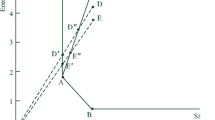Abstract
This paper uses Data Envelopment Analysis tocompute input-based technical efficiencymeasures and CO2 and energy technicalefficiency of specialised vegetable firms inthe Netherlands over the period 1991–1995. Input-based scale efficiency is also calculatedfor each firm. These efficiency measures aregenerated for firms with different heatingtechnologies. The empirical results indicatethat firms use energy quite efficiently and areless efficient in terms of CO2 emissions. Differences in CO2 (energy) efficiencyacross different technologies are (not)statistically significant. In particular,firms using traditional heating technologiesare less efficient in terms of CO2. Scaleadjustments can provide an importantcontribution to further efficiencyimprovements.
Similar content being viewed by others
References
Ball, V. E., C. A. K. Lovell, R. F. Nehring and A. Somwaru (1994), ‘Incorporating Undesirable Outputs into Models of Production’, Cahiers D'Économie et Sociologie Rurales 31, 60-73.
Ball, V. E., C. A. K. Lovell, H. Luu and R. Nehring (2000), ‘Incorporating Environmental Impacts in the Measurement of Agricultural Productivity Growth’, Paper presented at the International Conference on “Sustainable Energy: New Challenges for Agriculture and Implications for Land Use”, Wageningen, The Netherlands, May 18-20.
Chang, C. C. (1999), ‘The Nonparametric Risk-Adjusted Efficiency Measurement: An Application to Taiwan's Major Rural Financial Intermediaries’, American Journal of Agricultural Economics 81, 902-913.
Cordenier, M. F. C. (1999), Emissiereductie in de glastuinbouw: Een literatuurstudie en een effect rapportage. Msc thesis, Wageningen University.
Cox, T. L. and M. K. Wohlgenant (1986), ‘Prices and Quality Effects in Cross-Sectional Demand Analysis’, American Journal of Agricultural Economics 68, 908-919.
Färe, R. and S. Grosskopf (2000), Reference guide to Onfront. Economic Measurement and Quality I Lund AB. Färe, R., S. Grosskopf and C. A. K. Lovell (1985), The Measurement of Efficiency of Production. Dordrecht: Kluwer-Nijhoff Publishing.
Färe, R., S. Grosskopf, C. A. K. Lovell and C. Pasurka (1989), ‘Multilateral Productivity Comparisons When Some Outputs are Undesirable: A Nonparametric Approach’, Review of Economics and Statistics 71, 90-98.
Färe, R., S. Grosskopf and C. A. K. Lovell (1994), Production Frontiers. Cambridge: Cambridge University Press.
Pittman, R.W. (1983), ‘Multilateral Productivity Comparisons with Undesirable Outputs’, Economic Journal 93, 883-891.
Reinhard, S., C. A. K. Lovell and G. Thijssen (1999), ‘Econometric Estimation of Technical and Environmental Efficiency: An Application to Dutch Dairy Farms’, American Journal of Agricultural Economics 81, 44-60.
Reinhard, S. (1999), Econometric Analysis of Economic and Environmental Efficiency of Dutch Dairy Farms. Wageningen University, PhD thesis.
Stuurgroep Landbouw en Milieu (2000), Energieflits 4, March 2000.
Tyteca, D. (1997), ‘Linear Programming Models for the Measurement of Environmental Performance of Firms: Concepts and Empirical Results’, Journal of Productivity Analysis 8 183-197.
Author information
Authors and Affiliations
Rights and permissions
About this article
Cite this article
Lansink, A.O., Silva, E. CO2 and Energy Efficiency of Different Heating Technologies in the Dutch Glasshouse Industry. Environ Resource Econ 24, 395–407 (2003). https://doi.org/10.1023/A:1023684316366
Issue Date:
DOI: https://doi.org/10.1023/A:1023684316366




